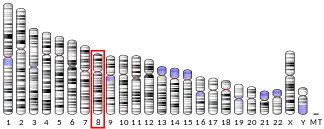Proenkephalin
Introduction
Proenkephalin (PENK), formerly known as proenkephalin A (since proenkephalin B was renamed prodynorphin), is an endogenous opioid polypeptide hormone which, via proteolyic cleavage, produces the enkephalin peptides [Met]enkephalin, and to a lesser extent, [Leu]enkephalin.[5] Upon cleavage, each proenkephalin peptide results in the generation of four copies of [Met]enkephalin, two extended copies of [Met]enkephalin, and one copy of [Leu]enkephalin.[5] Contrarily, [Leu]enkephalin] is predominantly synthesized from prodynorphin, which produces three copies of it per cleavage, and no copies of [Met]enkephalin. Other endogenous opioid peptides produced by proenkephalin include adrenorphin,[6] amidorphin,[7] BAM-18,[8] BAM-20P,[9] BAM-22P,[9] peptide B,[10] peptide E,[11] and peptide F.[12]
Proenkephalin in human diseases
Proenkephalin is produced by the medium spiny neurons of the striatum which undergo neurodegeneration in early stages of Huntington's disease (HD). PENK[13] and related peptides[14][15] measured in cerebrospinal fluid are proposed as potential biomarkers of disease progression in HD.
See also
- Prodynorphin (Proenkephalin B)
- Proopiomelanocortin (POMC)
References
- GRCh38: Ensembl release 89: ENSG00000181195 - Ensembl, May 2017
- GRCm38: Ensembl release 89: ENSMUSG00000045573 - Ensembl, May 2017
- "Human PubMed Reference:". National Center for Biotechnology Information, U.S. National Library of Medicine.
- "Mouse PubMed Reference:". National Center for Biotechnology Information, U.S. National Library of Medicine.
- Donald W. Pfaff (2002). Hormones, brain, and behavior. Elsevier. p. 173. ISBN 978-0-12-532109-9. Retrieved 25 November 2011.
- Matsuo H, Miyata A, Mizuno K (1983). "Novel C-terminally amidated opioid peptide in human phaeochromocytoma tumour". Nature. 305 (5936): 721–723. Bibcode:1983Natur.305..721M. doi:10.1038/305721a0. PMID 6633641. S2CID 4320171.
- Seizinger BR, Liebisch DC, Gramsch C, Herz A, Weber E, Evans CJ, et al. (1985). "Isolation and structure of a novel C-terminally amidated opioid peptide, amidorphin, from bovine adrenal medulla". Nature. 313 (5997): 57–59. Bibcode:1985Natur.313...57S. doi:10.1038/313057a0. PMID 3965972. S2CID 4363051.
- Hurlbut DE, Evans CJ, Barchas JD, Leslie FM (June 1987). "Pharmacological properties of a proenkephalin A-derived opioid peptide: BAM 18". European Journal of Pharmacology. 138 (3): 359–366. doi:10.1016/0014-2999(87)90474-2. PMID 3040439.
- Mizuno K, Minamino N, Kangawa K, Matsuo H (December 1980). "A new family of endogenous "big" Met-enkephalins from bovine adrenal medulla: purification and structure of docosa- (BAM-22P) and eicosapeptide (BAM-20P) with very potent opiate activity". Biochemical and Biophysical Research Communications. 97 (4): 1283–1290. doi:10.1016/S0006-291X(80)80005-2. PMID 7213356.
- Micanovic R, Kruggel W, Ray P, Lewis RV (1984). "Purification and sequence of a non-opioid peptide derived from ovine proenkephalin: implications for possible species specific processing". Peptides. 5 (5): 853–856. doi:10.1016/0196-9781(84)90105-0. PMID 6504720. S2CID 3869685.
- Boarder MR, Evans C, Adams M, Erdelyi E, Barchas JD (December 1987). "Peptide E and its products, BAM 18 and Leu-enkephalin, in bovine adrenal medulla and cultured chromaffin cells: release in response to stimulation". Journal of Neurochemistry. 49 (6): 1824–1832. doi:10.1111/j.1471-4159.1987.tb02443.x. PMID 3681299. S2CID 19919675.
- Jones BN, Stern AS, Lewis RV, Kimura S, Stein S, Udenfriend S, Shively JE (October 1980). "Structure of two adrenal polypeptides containing multiple enkephalin sequences". Archives of Biochemistry and Biophysics. 204 (1): 392–395. doi:10.1016/0003-9861(80)90048-X. PMID 7425644.
- Niemela V, Landtblom AM, Nyholm D, Kneider M, Constantinescu R, Paucar M, et al. (February 2021). "Proenkephalin Decreases in Cerebrospinal Fluid with Symptom Progression of Huntington's Disease". Movement Disorders. 36 (2): 481–491. doi:10.1002/mds.28391. PMC 7984171. PMID 33247616.
- Iadarola MJ, Mouradian MM (February 1989). "Decrease in a proenkephalin peptide in cerebrospinal fluid in Huntington's disease and progressive supranuclear palsy". Brain Research. 479 (2): 397–401. doi:10.1016/0006-8993(89)91648-X. PMID 2522341. S2CID 11033749.
- Barschke P, Abu-Rumeileh S, Al Shweiki MH, Barba L, Paolini Paoletti F, Oeckl P, et al. (June 2022). "Cerebrospinal fluid levels of proenkephalin and prodynorphin are differentially altered in Huntington's and Parkinson's disease". Journal of Neurology. 269 (9): 5136–5143. doi:10.1007/s00415-022-11187-8. PMC 9363351. PMID 35737109. S2CID 249930318.
External links
- Pro-Enkephalin at the U.S. National Library of Medicine Medical Subject Headings (MeSH)



